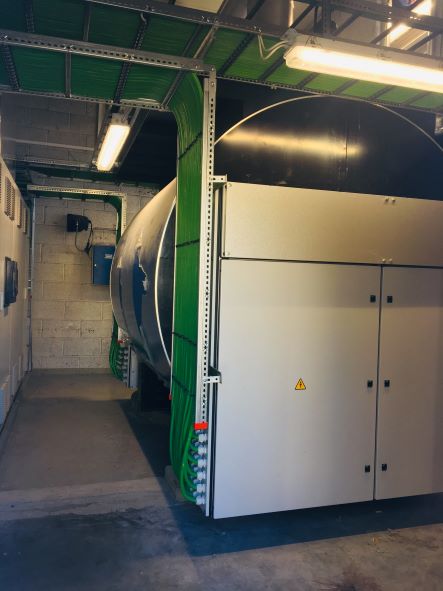Please click here to access the main AHDB website and other sectors.
- Home
- Knowledge library
- Electrification of Heat
Electrification of Heat
These pages describe options and considerations for generating heat in glasshouses using electricity rather than through direct fuel combustion.
What is electrification of heat?
Traditionally, heating in horticulture is provided through fuel combustion. Oil and natural gas boilers, and more recently biomass boilers and natural gas CHPs are the dominating technologies. Often sites have a combination of these technologies to make the most of their individual benefits and mitigate their drawbacks.
Electrification of heat describes generating heat with electricity, rather than fuel combustion, which is possible both by direct heating and by employing heat pump technology. Although electrification of heat is typically more efficient than combustion, the capital costs of the technologies are often much higher, and electricity itself is more costly than combustion fuels. As the electricity grid decarbonises over the coming years, electrified heat will be less carbon intense and will deliver carbon savings over fuel combustion to help achieve Net Zero targets.
What Options are there?
The commercial options for electrification of heat are heat pumps and electric boilers.
Heat pumps come in three broad categories:
- air source
- ground source
- water source.
Each of these work by using electricity to transfer heat from a lower to a higher temperature. The differences come in the heat sources and transfer media
Air source heat pumps (ASHPs)
These transfer heat from colder ambient air to warmer indoor air without a medium change, and are best suited for space heating, particularly low-grade heating in domestic or office applications. They are the least efficient of the heat pumps, particularly when ambient temperature is low: ranging from 4 in mild weather to as low as 2.5 in colder temperatures. Unfortunately, this is often the time that heat is needed most. This occurs because as the difference between source and delivery temperature increases, more electricity is needed to facilitate the heat transfer. The main benefit of ASHPs is that they are cheaper than other heat pumps.
When talking about heat pump efficiency, we’re describing the units of energy out compared to the units of energy in, often called Coefficient of Performance (CoP). Heat pumps typically have CoP between 2.5 - 4.5, meaning they deliver between 2.5 to 4.5 units of heat for each unit of electricity consumed. For comparison, new condensing boilers typically reach efficiencies of 0.95 (95%).
See how electrification heating systems compare on emissions and financially
Ground source heat pumps (GSHPs) and water source heat pumps (WSHPs)
These are broadly similar to one another, with heat sources of the ground and a natural water reservoir, respectively. Due to the seasonal consistency in ground and water temperatures, the efficiency of these systems is high, and they maintain that efficiency throughout the peak heating season.
GSHPs come in two broad types: horizontal loop and vertical borehole systems. Horizontal systems require more space, but are cheaper, whereas vertical systems require less space and can get access to more consistent source temperatures (and therefore higher efficiencies) but are more expensive.
WSHPs also come in two broad types: open-loop systems, which pump water from the reservoir directly into the heat pump; and closed-loop systems, which transfer heat from the source into a liquid transfer medium which is pumped through the heat pump. The type of system installed is determined by the nature of the available reservoir. WSHPs are generally the most efficient of the heat pumps, however, they require a nearby reservoir which is large enough to satisfy the heat demand, and it is more difficult to obtain the planning and environmental permits needed to install them.
Heat pumps and how they work, including The practicalities of installing a heat pump system provides more detail on heat pump technology.
See how electrification heating systems compare on emissions and financially
Electric boilers
Another commercial option for electric heating is electric boilers which work by running electricity through submerged heating elements. The benefit to these systems is that they can be cheaper to install than natural gas equivalents, and they can easily be retrofitted into existing heating infrastructure because they can work at high temperature output, unlike heat pumps. Additionally, electric boilers have very little input losses, working at an efficiency of around 99%. Due to the current cost of electricity in the energy market, they are still more expensive to run than a natural gas boiler.
See how electrification heating systems compare on emissions and financially
Electric direct fired air heaters
These may also be an option for smaller glasshouses without wet heating systems, particularly in frost protection applications, which have an efficiency of 100%. It’s worth mentioning that while these are the current commercial options, new developments in technology could provide additional options. For example, there are small domestic heating systems available which use electricity-powered microwave water heating.
See how electrification heating systems compare on emissions and financially
Useful links
Visit our GrowSave pages to read more about how you can save energy and improve efficiencies
Read more about the electrification of heat: Key market drivers and considerations
Energy management – read some top tips for remembering the basics
Watch our webinar below: Taking steps towards net zero

Courtesy and copyright of Danstoker A/S

